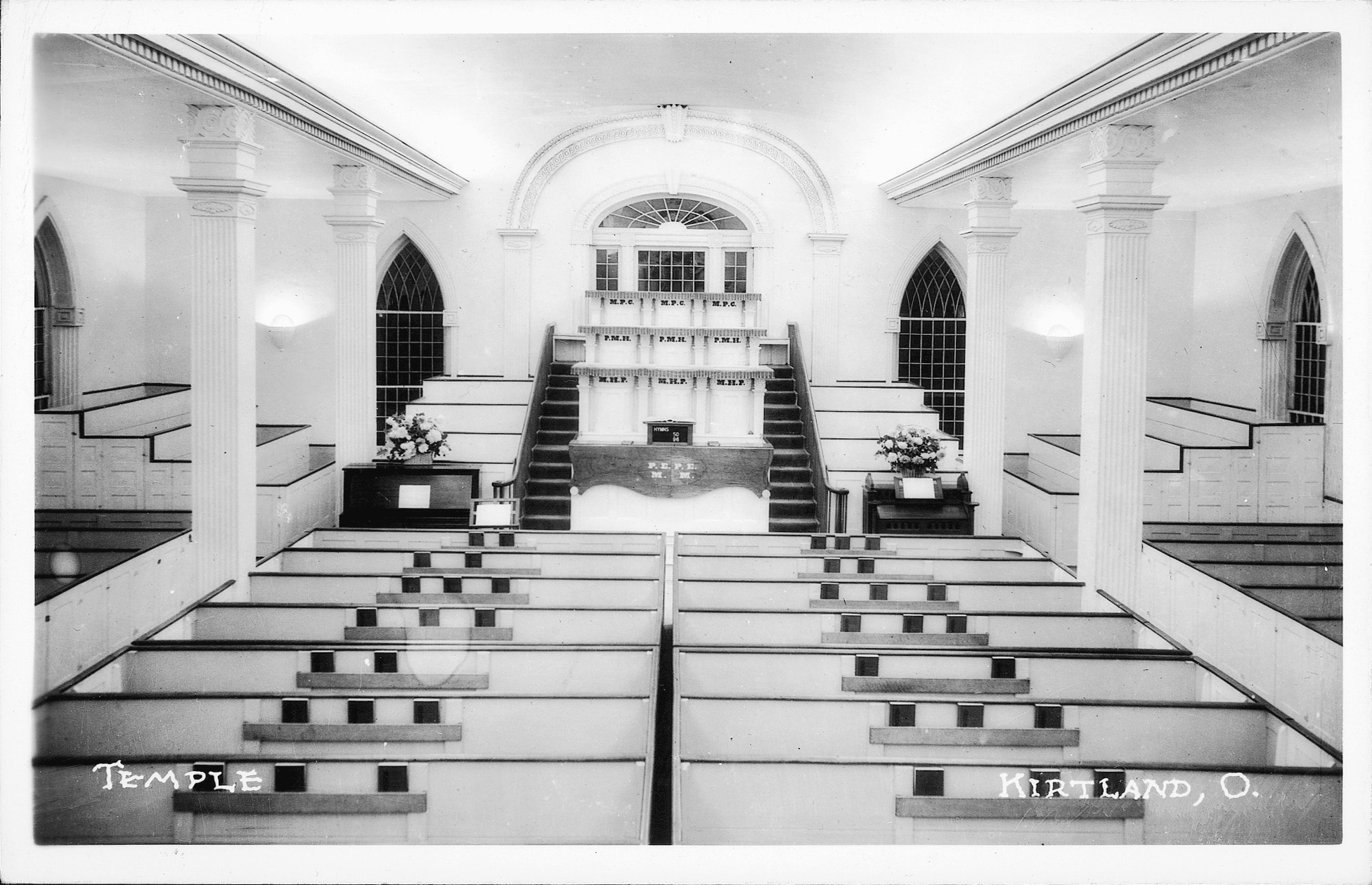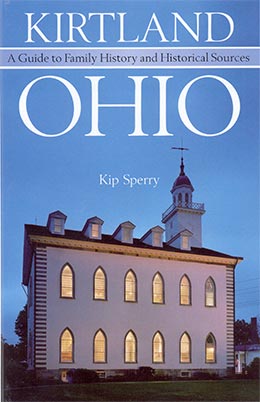Appendix: Geauga County Records
Kip Sperry, Kirtland, Ohio: A Guide to Family History and Historical Sources (Provo, Utah: Religious Studies Center, Brigham Young University, 2005) 213–218.
 Kirtland Temple, ca. 1912, lower auditorium, showing the Melchizedek
Kirtland Temple, ca. 1912, lower auditorium, showing the Melchizedek
Priesthood pulpits. Courtesy of L. Tom Perry Special Collections, Harold
B. Lee Library, Brigham Young University, Provo, Utah.
Kip Sperry
NINETEENTH-CENTURY GEAUGA COUNTY, OHIO, RECORDS are listed below. These records are available at the Family History Library in Salt Lake City and they may be loaned to Family History Centers. Family History Library microfilm numbers may be obtained from the online Family History Library Catalog (www.familysearch.org) or on CD-ROM . [1]
Geauga County (Ohio). Assessor. Personal Taxable Property, 1833–1837.
Geauga County (Ohio). Assessor. Returns, 1846–1853.
Geauga County (Ohio). Auditor. Duplicate Tax Records, 1816–1850.
Geauga County (Ohio). Auditor. Tax Maps, 1880. Geauga County (Ohio). Auditor. Tax Records, 1820–1869.
Geauga County (Ohio). Board of Commissioners. Account Book, 1806–1830.
Geauga County (Ohio). Board of Commissioners. Commissioners Journal, 1806–1879.
Geauga County (Ohio). Board of Commissioners. List of Houses which were Appraised, 1825–1830.
Geauga County (Ohio). Board of Commissioners. Records, 1805–1864.
Geauga County (Ohio). Board of Commissioners. Road Records, 1806–1884.
Geauga County (Ohio). County Recorder. Deed Records, 1795–1921.
Includes names of Latter-day Saints and others who resided in Geauga County. Land records are indexed by grantee (buyer) and grantor (seller). Land and tax records are two of the most valuable records for locating early Kirtland residents. [2]
Geauga County (Ohio). County Recorder. Record Book, 1825–1858.
Geauga County (Ohio). County Recorder. Record of Incorporations, 1845–1906.
Geauga County (Ohio). County Recorder. Record of Mechanic Liens, 1848–1880.
Geauga County (Ohio). County Surveyor. Surveyors’ Records, 1834–1874.
Geauga County (Ohio). County Treasurer. Book of Accounts, 1819–1865.
Geauga County (Ohio). County Treasurer. Order Books, 1831–1886.
Geauga County (Ohio). County Treasurer. Witness Record, 1848–1872.
Geauga County (Ohio). Justice of the Peace. Docket Book of Benjamin Morse, Justice of the Peace in Geauga and Trumbull Counties, Ohio, 1805–1809.
Geauga County (Ohio). Probate Judge. Birth and Death Records, 1867–1908.
Kirtland, Ohio, Kirtland Tax Records. Original tax record books at the Geauga County Archives and Records Center, Chardon, Ohio:
• Kirtland Township, 1830, 1833, 1834, 1839.
Rate of Taxation in Geauga County.
Kirtland Township No. 9 in the 9th Range.
Shows owners’ names; range, township, tract, lot; number of acres; value of lands, houses, factories, etc.; total value.
• Kirtland Personal Property, 1830, 1833, 1838, 1839. Shows owners’ names, number of horses and value, number of cattle and value, merchant capital, total value, state tax,
county tax, road tax, township tax, total amount. Note, there are no 1834 Kirtland tax records in these volumes. [3]
Ohio. Court of Common Pleas (Geauga County). Appearance Docket, 1866–1874.
Ohio. Court of Common Pleas (Geauga County). Court Records, 1807–1904.
Ohio. Court of Common Pleas (Geauga County). Trial List, 1859–1864.
Ohio. District Court (Geauga County). Court Records, 1853–1884.
Ohio. Probate Court (Geauga County). Administration Bonds and Letters, 1871–1887.
Ohio. Probate Court (Geauga County). Inventory and Sale Bills, 1853–1886.
Ohio. Probate Court (Geauga County). Marriage Records, 1806–1920.
Includes general index and individual volume indexes to Geauga County marriage records, 1806–1920. Marriage licenses are also included in these records.
Ohio. Probate Court (Geauga County). Naturalization Records, 1860–1912.
Ohio. Probate Court (Geauga County). Probate Files. Probate files are alphabetically arranged by surname.
Ohio. Probate Court (Geauga County). Probate Records, 1806–1941.
Includes a general index and individual indexes for most probate volumes.
Ohio. Supreme Court (Geauga County). Court Records, 1806–1884.
Notes
[1] Many Geauga County, Ohio, genealogical and historical records are also on microfilm at the Harold B. Lee Library, Brigham Young University, Provo, Utah; Ohio Historical Society, Columbus, Ohio; Western Reserve Historical Society, Cleveland, Ohio; and other repositories.
[2] A useful reference for research into Ohio land records is George W. Knepper, The Official Ohio Lands Book (Columbus: Auditor of State, 2002), paperback and online at www.auditor.state.oh.us. Also useful is Along the Ohio Trail: A Short History of Ohio Lands (Columbus: Auditor of State, 2001), and “Introduction to Ohio Land History” atwww.ultranet.com/-deeds/
[3] Joseph Smith Jr., Hiram Smith, Newel K. Whitney, and other early LDS Church leaders and members are shown in these tax records, along with the items taxed (such as cattle and horses) and amount of tax. See, for example, Geauga County Tax Duplicate for 1839 for Kirtland Township for Joseph Smith Sr., Joseph Smith Jr., and Emma Smith, showing location of property, number of acres, value, and amount taxed.
Other local government records are housed at the Geauga County Archives and Records Center, Chardon, Ohio (www.co. geauga.oh.us/
Personal Property Tax Duplicate for 1826, Kirtland Township, Geauga County, Ohio (includes the area that is now Lake County) shows owners’ names; number of horses, mules, and asses; aggregate value; number of cattle; aggregate value, capital of merchandise and brokers; number of pleasure carriages and aggregate value; signatures of persons taxed; and remarks (such as “owner from home”). In 1826 Newell K. Whitney had $2,500 in capital and one cow valued at $8.
